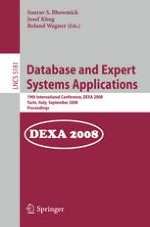This book constitutes the refereed proceedings of the 19th International Conference on Database and Expert Systems Applications, DEXA 2008, held in Turin, Italy, in September 2008. The 74 revised full papers presented together with 1 invited paper were carefully reviewed and selected from 208 submissions. The papers are organized in topical sections on data privacy; temporal, spatial and high dimensional databases; semantic Web and ontologies; query processing; Web and information retrieval; mobile data and information; data and information streams; data mining algorithms; multimedia databases; data mining systems, data warehousing, OLAP; data and information semantics; XML databases; applications of database, information, and decision support systems; and schema, process and knowledge modelling and evolution.
